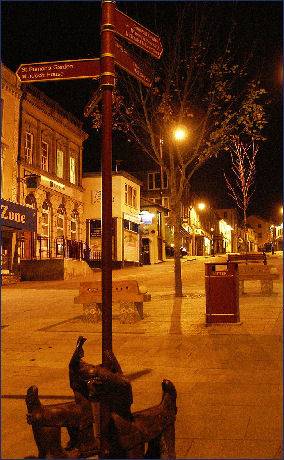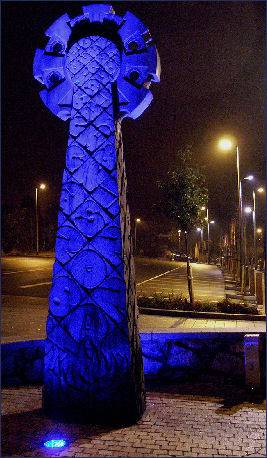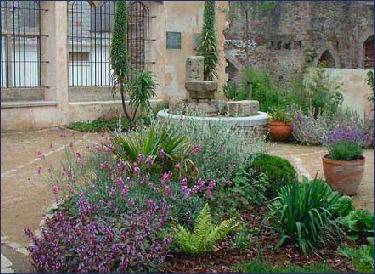Redruth
OS Grid ref:-

 The bustling town of Redruth, the largest town in Cornwall, is situated 12 miles (19 km) to the east of the popular resort of St Ives.
The bustling town of Redruth, the largest town in Cornwall, is situated 12 miles (19 km) to the east of the popular resort of St Ives.
The name Redruth derives from its Cornish equivelant of Rhyd-ruth. Rhyd meaning a ford across a river and ruth which is the old Cornish word for red.
The town has its origins in the twelfth century. It has been recorded that by the fourteenth century, when Redruth was still only a village, the stream running along the bottom of Fore Street ran red as it was so discoloured with iron oxide from tin mining.
Redruth grew slowly through the sixteenth and seventeenth centuries and acquired the status of a small market town, In the mid eighteenth century it was described as consisting of one main street almost half a mile long. In the eighteenth century, a boom in the demand for copper ore developed. Surrounded by copper ore deposits, Redruth rapidly developed into one of the largest and richest mining areas in Britain and the town's population increased markedly.
The granite Church of St Euny, known in Cornish as Rysrudh Sen Unia is a Grade II listed building, it is set in beautiful grounds on picturesque Church Lane. The church stands on Norman foundations but was rebuilt in 1756, the tower dates to two centuries earlier and belonged to the previous church, it has three stages and is substantially buttressed at the square of the angles.
Saint Euny or Uny was an Irish missionary like St. Columba or St. Gall or St. Columbanus. His feast was kept on the 1st of February. The cult of St. Euny, so far as the evidence at present available shows, seems to be purely popular, not liturgical.
The church with its surrounding cottages is overlooked by Carn Brea, known in Cornish as Karnbre. Carn Brea Castle began life as a medieval hunting lodge, built in the fifteenth century (it may have been adapted from an earlier chapel which occupied the site) by the wealthy Bassett family of Tehidy. Over the proceeding centuries the castle has been extensively restored and extended to the point where it now resembles a folly. In Neolithic times, Carn Brea was the site of a large settlement which existed between 3700 and 3400 BC. A two acre inner enclosure was surrounded by a eleven acre outer area. The site was excavated in 1895 by Thurston Peter. He investigated some of the circular huts inside the ancient settlement, and unearthed many interesting finds. A coin of Macias, King of Namibian in North Africa 148-115 B.C., has been discovered there.
 Murdoch House on Cross Street dates to the 1660s. It began life as a chapel and later came to be used as a prison. William Murdoch occupied the building from 1782 to 1798. He was employed building engines at the tin and copper mines in the area.
He fitted the house out with gas lighting from coal gas, making it the first house in the world with this type of lighting. Murdoch House has since been fully restored. Murdoch House also houses the Cornish Global Migration Programme who have a complex database containing biographical details of many thousands of Cornish migrants and can provide a link with Cornish ancestors worldwide.
Murdoch House on Cross Street dates to the 1660s. It began life as a chapel and later came to be used as a prison. William Murdoch occupied the building from 1782 to 1798. He was employed building engines at the tin and copper mines in the area.
He fitted the house out with gas lighting from coal gas, making it the first house in the world with this type of lighting. Murdoch House has since been fully restored. Murdoch House also houses the Cornish Global Migration Programme who have a complex database containing biographical details of many thousands of Cornish migrants and can provide a link with Cornish ancestors worldwide.
St. Rumon's Gardens, (pictured left) which stand next door to Murdoch House are contained within the ruined walls of Druids Hall. A fourteenth century stone cross stands in front of ornamental gardens.
Occupying the site of an old Tin Mine and set amidst highly atttractive gardens, Cornwall Gold is a major family attraction and is completely free to enter. The park hosts an array of great activities for all ages, colourful floral displays follow the twists of Tolgus Stream which runs through the center of the park and guide the visitor around paths where many retail, family and heritage outlets can be enjoyed. The Redruth Town Museum stands on the site, where visitors can discover more about the mine that the site occupies with mining artefacts, tools, maps and tin ingots on display.
A bronze sculpture of a Cornish miner by artist David Annand stands two 6 feet 7 inches high and was erected in the town in 2008. The Redruth Town Trail is a short walk through the town, featuring places of historical interest.